WORK DONE LAST WEEK





 You worked quite hard on your Aboriginal Reports. The Family group has already given theirs to me, so you can read it here: Aboriginal Family and Social Justice written by Jie, Rita, Silvia and Sue. The culture group has also handed in their report: Aboriginal Cultural Heritage
You worked quite hard on your Aboriginal Reports. The Family group has already given theirs to me, so you can read it here: Aboriginal Family and Social Justice written by Jie, Rita, Silvia and Sue. The culture group has also handed in their report: Aboriginal Cultural Heritage
The forum on Women's Health & Kylie Minogue was not well attended, maybe it was too hard or you had too much other work to do. But remember: it's very important to be critical when reading anything. You have to ask yourself: Why are they saying this? Who are they? Why have they chosen these pictures? Do they want to sell me anything? Do they want my vote?



Thanks a lot for taking part in Library Week and for helping with the tea and coffee. You all did a terrific job, and Shery was there till the last person left! Laura, one of the librarians, sent a thank you note:I would like to thank your wonderful students and yourself for your contribution to the Library Week morning tea.
Kind Regards
Laura


If you want to read the questions of 'What's in the box?" Eva has posted them in her blog. It'll be interesting to see if anyone (from around the world) guesses it. Congratulations to you too, Eva, for winning the cinema tickets!
Congratulations to other three winners: Shery, Sue and Jian. They got very good prizes. Sue and Jian guessed what was in the box and got $40 vouchers for a couple of department stores. Shery guessed the amount of sweets in the box (102) and got them all as a prize!

Our class blog was exhibited in one of the library computers. We hope it inspired some students to join the blog community.
And a warm WELCOME to Suzy, your new classmate!
Suzy, you can try to create your blog by yourself. There is a fantastic Tutorial (Blogger.com Tutorial) that will help you. Click on it and follow the instructions. There is a permanent link to it below the Blogger button (on the right sidebar, at the very end)
Indigenous Australians-Family & Social Justice
Report written by Jie, Rita, Silvia & Sue INDIGENOUS AUSTRALIANSIndigenous peole in Australia, who are the first Australians, have their particular traditional lifestyles.Family
INDIGENOUS AUSTRALIANSIndigenous peole in Australia, who are the first Australians, have their particular traditional lifestyles.Family
Aboriginal and Torres Strait Island people have a very complex system of family. They use particular ways to educate children and pass knowledge and skills to the next generation. Their lifestyle is different to western people, and they have their own toys and games.
Every adult in the family is like the children’s parents and has the responsibility to educate and care for the children. One of the things all children learn is who other people are in relation to them: uncles, aunts, cousins and later brother-in-law and mother-in-law.
Fathers-in-law and sons-in-law maintain an avoidance relationship, they will rarely speak to each other directly, but communicate through a third party, and often they will avoid being in the same room as each other.
Girls marry when they are 14 or 15 years old, and boys in their 20s. They never used to separate, but that is changing now.
The elders and storytellers have an important position in the family. They pass their skill, knowledge, personal experiences and important traditions to the young people. The mothers usually indulge their children, boys in particular. However the elders or the father disciplined the boys and were very strict.
Aboriginal people have their traditional tools, weapons and toys . They play particular games, such as string games. String games were also used to help tell stories.
Since the late 1800s until 1969, the Australian government had a policy of taking Aboriginal children from their families. The children were adopted by white families or were put into government institutions. This policy failed. The Aboriginal children haven’t changed into white children. That generation was to be called the “stolen generation”

hands
Social JusticeIndigenous people are the first Australians, but since the Brithish landed in Australia, they have suffered racial discrimination from the governments and the community. Indigenous people did not get the same rights and services as non-Indigenous people in areas of health, population, employment, income, accommodation, public education, law and justice.
In 1965 Indigenous people started to fight for their rights with the Freedom Rides in NSW. Later some anti-discrimination legislations were drawn up But the struggle for social justice continues today.
(Information collected from interpretation signs at the Australian Museum & Museum's website)
Today's Work
- Go to Time4English and listen to Acupuncture (1A Intermediate)
- Go to THIS WEEK'S ODD SPOT and listen to it.
- Do the grammar (1B & 1C Intermediate)
- Read the post on women's health
- Go to the forum and write your opinion about the media reaction to Kylie Minogue's breast cancer
- Go to the forum and write your thoughts on women's health, breast self-examination, Kylie Minogue's case in the news, etc.
Aboriginal Cultural Heritage
Bing, Jian, Wei, Lily & Ivy
Maintaining one's cultural, values and traditions is very important. The Indigenous cultures of Australia are the oldest living cultures in the world.
Today, Indigenous communities keep culture alive by:
· Passing their knowledge, arts, crafts, rituals and performances from one generation to another.
· Speaking and teaching Aboriginal languages.
· Protecting cultural property and sacred sites and objects.
Archaeology
Archaeologists have found artefacts at Lake Mungo, Botany Bay and Parramatta.
Archaeological evidence shows that indigenous cultures have developed and changed a number of times as a result of changes in the environment.
The indigenous artefacts a t Lake Mungo date back to at least 33,000 years.
The indigenous artefacts at Botany Bay show evidence of a shell midden. A midden is a heap of shell form seafood eaten by Aboriginal people ( some date back to 3000 years).
Archaeologists have also found axes and flaked stone artefacts around Parramatta.
Baskets


Aboriginal people used baskets and bags to carry foods, babies, water and other objects. The baskets and bags are usually mad by Aboriginal men and women. They re woven using bark, human hair, pandanus and palm fronds, grasses and bush twine. They are coloured with dyes made from roots, bark and other natural substances and they are sometimes decorated with feather and pieces of cloth. The baskets also are woven in many different shapes: rectangular, round, crescent and cylindrical. For example the shape of the Pandanus basket is crescent l. The Pandanus basket comes from the Murray River in South Australia. The artist used a coil technique, used only in South Australia.
Shields

The Aboriginal men made the shields. They used them in dances, ceremonies and some times in defensive fight.
The narrowest shields were used in hand-to-hand fight. The wide ones to protect them form spears and other missiles. The rainforest people of north Queensland made th3e largest shields. They painted them with calm design colours.
The Daintree shield was collected from a rainforest region. It was used for ceremonies and defence in fighting. The shield was made from the buttress o a rainforest fig tree. It was carved into shape using hand tools. The handle cavity was creat4ed by burning and chipping the wood.
(Information collected from interpretation signs at the Australian Museum & Museum's website)
Women's Health
Last week we had a very informative session on breast examination, Pap smears and pelvic floor exercises. (Sorry Bingbing, but I think this is very important. You can learn about it and tell Echo). WOMEN'S
HEALTH IS OUR RIGHT and OUR
RESPONSIBILITYYOUR body IS THE container of your MIND & SPIRIT.
DO NOT NEGLECT IT!
 It wasn't easy to understand everything because of all the new medical words. Have a look at the leaflets the nurse gave us and visit these web sites:Breast
It wasn't easy to understand everything because of all the new medical words. Have a look at the leaflets the nurse gave us and visit these web sites:Breast
It was a coincidence that on the same evening we heard the news about Kylie Minogue's breast cancer.
Read the following articles, from three different sources:
Kylie has breast cancer (Sky Showbixz) Kylie Battling Cancer (Rolling Stones) Superstar Kylie Minogue diagnosed with Breast Cancer (Teen Music, About)When you finish reading all three versions of the same story, write in your blog about the differences and similarities between the three. Answer these questions to help you organise your thoughts:
1. Do they present the same content, the same information?
2. Do they use photos in an honest way? Or do they manipulate them to affect our feelings?
3. What is around the article? Are they trying to sell something? Are they adding useful information?
4. Do they give serious information or just anecdotes about the singer?
5. Which article is more believable and why?
6. Do you think it's ok to talk about a famous person's medical problems? Why?
Library Week
LIBRARY WEEK
Library week starts on Monday 23rd May – Friday 27th May.
We have been invited to display our class blogs, so make sure you have all the work done, corrected and put nice photos in your blog.
The libray is having a Morning Tea for everyone on Wednesday 25th May at 10:30. Make sure you remind Marion. You are needed to help serve it. I will be there too.
It's great that other students can see your work. They may be inspired to write their own blogs and thus practise their English in a very exciting way!

Look at this fantastic idea: voice blog messages!
TODAY'S WORK
 lilies
lilies
I promised to let you work on your reports on Indigenous Australians today, so I haven't prepared a lot of work.
- Go to Time4English and have a look at the medical section in Level 5 (Intermediate) and do 1G about physical exercise (listening).
- Do 1H & 1I Talking about Sickness & Ailments (vocabulary)
- Do your research for your report on Indigenous Australians
- If you have time, read the power point presentation by the Blooming Bloggers
- For homework do the writing in Time4English Level 5 Medicine (1J)
All About Good Blogging
Have a look to this fantastic power point presentation by the Blooming Bloggers, the participants in the Write Weblog (see right sidebar link). It is called
The DownloadBloomingBloggersShow.ppt(in the post T.A.G. Blogging Machine.You will need power point to open it.
TheBlooming Bloggers are young students from a primary school in Gerogia (USA). They give tips (ideas) on how to write a good blog. Read them. You will learn a lot from them. You can also look at their blog,
The Write Weblog, visit each student's blog (links on the left sidebar)and write to them in their comments.
Group Work
Indigenous Australians
Monday's work with MarionYou have to write a group report on a specific Indeginous Australian aspect: Aboriginal Spirituality, Family, Land and Social Justice or Cultural Heritage.
Go to Excursion to the Australian Museum if you need to check your group's research on Aboriginal Spirituality, Family. Land and Social Justice or Cultural Heritage. You will find links to these particular aspects of Aboriginal culture.
Visit the post Indigenous Australians for extra information. There is also a very good interactive exercise on how to use a mouse and keyboard.
Today's Work
Last week's Forum summary: - Most of the students from China said that celebrating Mother's Day is a new thing in China. Some started celebrating it by buying their mum a present or taking her to a restaurant, others didn't do anything and a couple feel guilty about it. They say it is because now that they live in Australia, they miss their mother. Olga's comment is very funny, read it. Apparently men have to buy presents for all the women they know, even their wives' friends and their women neighbours! Lily tells us about Father's Day in China. This is what she says:
In China, every year's 8th August is Father's Day. Because the 8th August in Chinese pronunciation is 'ba ba', and papa in Chinese pronunciation is 'ba ba' too. So every year on the 8th August we can think of 'Ah, my dad, where's he?'
- This week's FORUM: Go to Time4English Intermediate (5D) and listen to the story on Korean women and changes in traditional roles. Is this happening in other countries. Has it happened in your country of origin? What do you think about it? Is it a good thing that women and men's roles are changing in modern society? Tell us your opinion and respond to your clasmates' opinions.
- Go to Time4English and listen to THIS WEEK'S ODD SPOT. What's the matter with the chimpanzee? How do they say he's trying to give up a bad habit?
- Go to Upper Intermediate/Advanced (2I) and listen to The Great Wall of China. What type of text is it? Write the answer in your blog.
- Click on DICTATION (upper right hand corner of Upper Intermediate/Advanced) and do dictation 2F Bad drivers (some of our students are failing their driving tests!)
- Read an EFL student's description of her mug (a cup for hot drinks) in her blog post, The Story. She talks about passing it on to her children and it reminded me of our conversations about family heritage and artefacts. It also made me think it would be a great idea if you started writing to other students of English in their blogs. (You will find ESL student blog links on the right sidebar of our blog). After you read her story, answer these questions in your blogs:
When and why did she get her bowl? What happened to it in 2000? What has she done to it? What is she going to do with it?
Do you have a similar object? Do you have an artifact passed on in your family? Tell us about it and post a photo of it (See Melzinha's bowl here)
6. If you have finished your Wombat report, post it in your blog.
- Monday's work with Marion: go to Excursion to the Australian Museum if you need to check your group's research on Aboriginal Spirituality, Family. Land and Social Justice or Cultural Heritage.
- Visit the post Indigenous Australians for extra information. There is also a very good interactive exercise on how to use a mouse and keyboard.
Indigenous Australians
On the 4th May, 2005 we visited the exhibition
Indigenous Australians at the Australian Museum.
 Visit this interesting site to learn keyboard skills and mouse skills for Aboriginal students: Indigenous Keyboard & Mouse Visit this site to learn more about ABORIGINAL AUSTRALIA ART & CULTURE CENTRE - ALICE SPRINGS Remember to look at the Museum's website for more information on Aboriginal culture, spirituality, social justice, etc. See the links in the post Excursion to the Australian Museum.
Visit this interesting site to learn keyboard skills and mouse skills for Aboriginal students: Indigenous Keyboard & Mouse Visit this site to learn more about ABORIGINAL AUSTRALIA ART & CULTURE CENTRE - ALICE SPRINGS Remember to look at the Museum's website for more information on Aboriginal culture, spirituality, social justice, etc. See the links in the post Excursion to the Australian Museum.
REPORTS: Information Texts
We've been looking at report writing in class.
The most importan things to remember are:
STRUCTURE |
|
|---|
| GENERAL CLASSIFICATION: name & group |
| DESCRIPTION OF PART # One paragraph for each different part: physical description;location & habitat;feeding habits; etc
|
| LANGUAGE | Simple present & relational verbs (be, have, includes, consists of,...) Wombats are....They live... eat.... |
| Generic nouns Wombats... Adult wombats.... Their babies... The wombat...
|
| Noun groups (article+adjectives+noun) Wombats have thick soft fur. |
| Circumstances of place (where), time (when) Most of the day they sleep in a burrow. In the evening or at night they go looking for food. |
| Circumstances of manner (how) A female wombat's pouch opens backwards so that when mum is digging she doesn't cover her baby with sand. |
Go to Time4English Lower Intermediate and read the Wombat story (you can listen to it, too). Is this text a report? Not really, because the wombat is talking to us (I, my pouch, my baby...) What changes do you have to make to the language, so that it is an information report?
Write a report about wombats based on that story.
You can add more information by searching the net. We also heard something very interesting about the wombats' pouches from David at the Australian Museum. See if you remember, if not ask another student or your teachers.
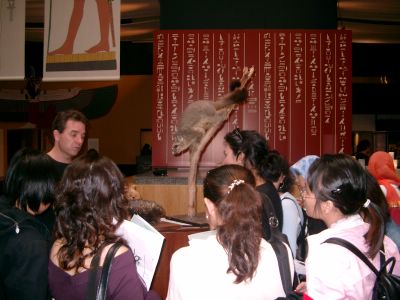
 David showed us some Australian native animals. Can you remember their names? Do they belong to the same species? What's their main characteristic?
David showed us some Australian native animals. Can you remember their names? Do they belong to the same species? What's their main characteristic?Labels: animals, museum, reports, wombats
Put your headphones on!
Today's Work
This week you are going to use your ears for English ... I know, I know, you use them every day (shopping, TV, your teachers, classmates, etc). Seriously now, I got a few headphones (the rest are coming...) so that those of you without a pc at home can practice a bit of listening.
- Go to Time4English and do the listening 5M Wombats (Lower Intermediate), 7B News -Present Perfect(Lower Intermediate) & 6H Music. When you finish, listen to Recent News about Zimbabwe & This Week's Odd Spot (Home Page).
- Go to this fantastic site I found in Jeffrey Hill's The English Blog: Learn a Song Podcast
- Explore other listening podcasts: ESL Listening Podcasts (I'll leave a permanent link on the right sidebar)
This Sunday is Mother Day. Do you celebrate it in your country of origin? Do you have Father's Day or any other Days? What do you think about these celebrations? Do you follow them? Do you get/buy presents? How do you celebrate them? Or maybe you think they are a waste of time and money? Go the our forum and tell us what you think.
4. Now a bit of grammar. More practice with the present perfect and the past simple in In English (Oxford University Press).
5. Do Mobile Madness in Activities (same Oxford site as above). You will learn what all teenagers know: mobile jargon ( a specific language used by a certain group of speakers)
6. Congratulations to Jie! Stephan has chosen her blog to show it to his students as a good model to learn & practise English! Have a look in her blog.
7. Also remember to look at the student blogs in ECML Bloggers, read a few and start writing to them. People love it when someone appreciates their work and it's a good incentive for them to continue writing and for you to practice more. You can put a link to your blog in your commetns and ask them to visit it. Remind me to show you how to insert (put) links.
8. New Competition: Spot the Difference! See who is the first student to find all the differences.
9. Congratulations to Lily! She has passed the Knowledge Driving Test! Ask her about it.
10. Thank you to every one for a perfect day yesterday. It was very enjoyable and we learnt a lot. Have a look at the photos in Excursion to the Australian Museum and the previous posts. There is help for your homework!
11. Regards from the teachers running Dakita. Read their comments.
Spot the difference
There are at least 10 differences between these two photos. Write the answers in your blogs.

Excursion to the Australian Museum
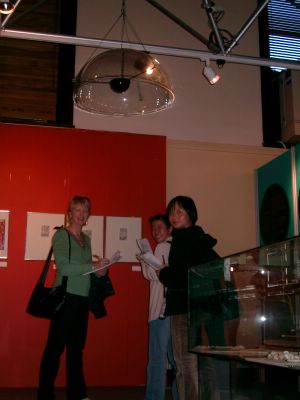
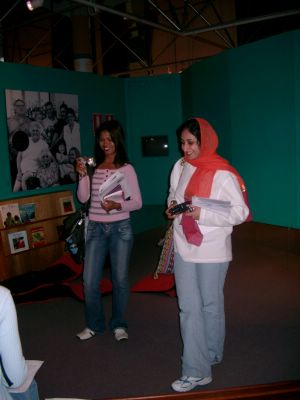 Marion, Rita Jie, Jian & SaidehToday we had a very interesting visit to the Australian Museum. Have a look a the photos below and answer the questions in your blogs or in comments. Marion and I commented on how great you all were. You were working very hard the whole time and nobody complained or left before the work was completed. All of this inspite of having power-walked all the way from Parliament House!
Marion, Rita Jie, Jian & SaidehToday we had a very interesting visit to the Australian Museum. Have a look a the photos below and answer the questions in your blogs or in comments. Marion and I commented on how great you all were. You were working very hard the whole time and nobody complained or left before the work was completed. All of this inspite of having power-walked all the way from Parliament House!
Our focus was the Indigenous Australians section. Visit the museum website, Dream Online, to learn more about them or to help you with your homework. You can find information for your group work on Aboriginal Cultural Heritage, Spirituality, Family, Land and Social Justice.
If you need help with the vocabulary (too many new words, we know) they have a fantastic Glossary. Check the time lines and the flags too.
It was very difficult to understand all the videos, but you did a great job!
The Skeleton Room
 Home Sweet Home What' happening in this blissful domestic scene?
Home Sweet Home What' happening in this blissful domestic scene? Cycling Race Who is Shery racing against? Who won?
Cycling Race Who is Shery racing against? Who won?
Aboriginal Culture & Aboriginal Art
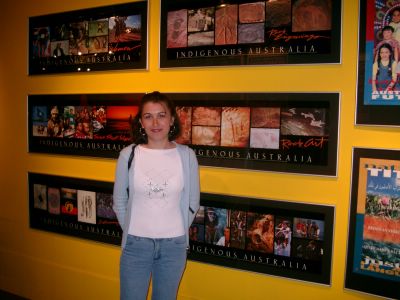
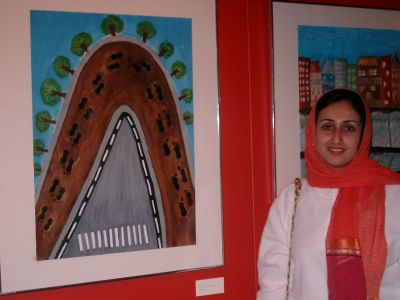
Shery & Saideh learning about Aboriginal Art
Totems
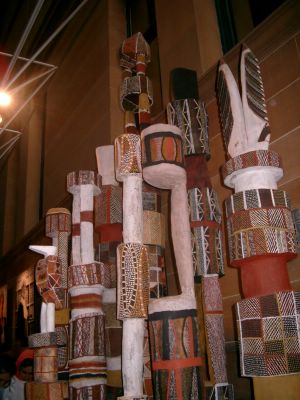 Burial Totems
Burial Totems
 Working hard
Working hard
Macquarie Street Buildings
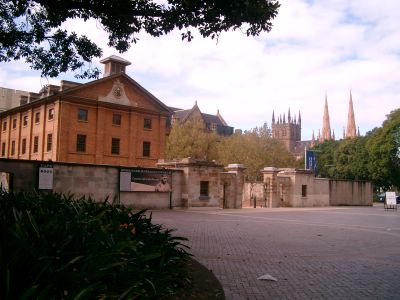
 Do you know the names of these buildings? Can you name other important buildings along Macquarie Street?
Do you know the names of these buildings? Can you name other important buildings along Macquarie Street?
Il Porcellino
 Il Porcelino. Wei is rubbing its snout for good luck! Where does Il Porcellino come from?
Il Porcelino. Wei is rubbing its snout for good luck! Where does Il Porcellino come from?
 Frog for dinner. Do you know the names of the other animals?
Frog for dinner. Do you know the names of the other animals?
Jie is going to be famous!
 You have to visit this new website for ESL/EFL teachers and students. Three very good teachers of English from different countries (Brasil, Japan,...) have set up this website, Dekita, where you can look at what other students of English are doing in different parts of the world . They have put a bit of text from Jie's blog and a link to it. Well done Jie!When you visit Dekita, go to ESML Bloggers and visit the main site, ECML Blog Brainstorm . There are some links on the right hand sidebar to English blogs. Click on them and it will take you to some blogs from Malta and Poland written by students of English like you. There are very interesting and well written.
You have to visit this new website for ESL/EFL teachers and students. Three very good teachers of English from different countries (Brasil, Japan,...) have set up this website, Dekita, where you can look at what other students of English are doing in different parts of the world . They have put a bit of text from Jie's blog and a link to it. Well done Jie!When you visit Dekita, go to ESML Bloggers and visit the main site, ECML Blog Brainstorm . There are some links on the right hand sidebar to English blogs. Click on them and it will take you to some blogs from Malta and Poland written by students of English like you. There are very interesting and well written.







































